#Boeing Business jet
Text


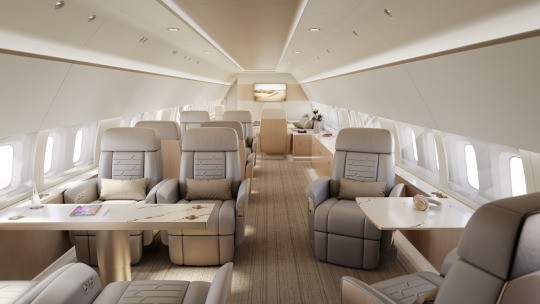


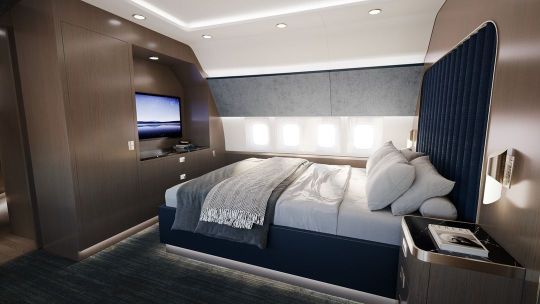

BBJ 737-7,
Boeing Business Jets has chosen a partnership between @aloftaeroarchitects and @greenpointtechnologies as the exclusive completions provider for the newly announced BBJ Select cabin interiors.
#art#design#flying private#travels#luxury lifestyle#private jet#flying palace#business jet#airplane#jetsetter#jetset#conceot#boeing#boeing business jet#BBJ 737-7#aloftaero architects#greenpoint#cabin interiors#billionairelife#render#bedroom
86 notes
·
View notes
Text

N834BA getting ready for a quick hop over to PDX from KHIO
#Boeing#737#737-73Q#BBJ#Boeing Business jet#private charter#charter jet#aircraft#airplane#plane#private jet#aviation
21 notes
·
View notes
Text
Boeing whistleblower found dead

View On WordPress
5 notes
·
View notes
Text
Some Features Of Boeing Business Offered To Customers
Boeing is one of the world's largest aerospace and defence companies, with a rich history of producing commercial airplanes, military aircraft, and space and defence systems. The company was founded in 1916 and has since become a major player in the aviation industry, offering a wide range of products and services to customers around the world.
These aircraft are used by airlines to transport passengers and cargo globally, and they have become some of the most recognizable and widely used planes in the world.
These aircraft are used by airlines to transport passengers and cargo globally, and they have become some of the most recognizable and widely used planes in the world. The company is known for its cutting-edge technology and innovative solutions and is known for delivering high-quality products and services to its customers.
The companies are working to recover from these challenges and continue their mission of shaping the future of aviation and aircraft.
Here are the features of Boeing Business Jet charter service a customer can enjoy!
1- Customer Satisfaction
Boeing has a strong global presence, with customers and operations in countries around the world. The company's broad customer base and global reach provide a strong foundation for growth and stability.
2- Company's Profitability
Boeing offers a wide range of products and services across commercial airplanes, military aircraft, helicopters, space and defence systems, and services industries. This diversification helps reduce the company's dependence on any one area of the business.
Boeing has built strong partnerships and collaborations with other companies, governments, and organizations in the aerospace and defence industries.
3- Productivity Problems
Boeing is committed to sustainability and is working to reduce its environmental impact, promote energy efficiency, and create a more sustainable future for aviation. The company has set ambitious sustainability goals and is taking steps to achieve them.
Productivity helps the company access new markets, share resources, and achieve common goals.
4- Quality
Boeing has a long history of investing in research and development and is known for its cutting-edge technology and innovative solutions. The company's focus on innovation and technology helps it stay at the forefront of the aerospace and defence industries.
One Last Take
These are the features of Boeing's business that impact the aircraft industry. You will find all these features in a certified flight company providing Boeing and management services.
Fly Elite Jets Ltd. provide Boeing Business Jet charter service to all its special clients. You can get jet charter service of high lavish amenities.
Please go through our website and book your Boeing jet charter now.
0 notes
Text
Boeing Whistleblower DeathWatch Commenced.
39 notes
·
View notes
Text
No. 32 - Japan Transocean Air Jinbei Jets
Over the past two days, @lillybean730, @whatmorecouldapoorboydo, and @fungaloids have all tagged me in this post, which contains this image.
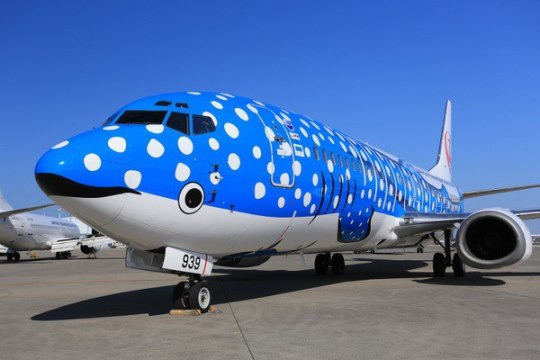
The link beneath is broken, but based on the text below, I would presume it was posted in response to the introduction into service of Japan Transocean Air's two "Jinbei Jets". ('Jinbei-zame' is the Japanese name for whale sharks!)


That's right, there are two of them! The Jinbei Jet actually comes with a matching Sakura Jinbei! They're both Boeing 737-800s delivered new to JTA (a JAL subsidiary based in Naha which usually just uses the JAL livery, hence the vestigial Tsurumaru logo on the tail) in late 2017; the blue Jinbei entered service in September while the Sakura entered service in December.

These are adorable, there's just no way around it. The low-sitting eyes, combined with the existence of the cockpits, does make it look a little like the plane has two sets of eyes, or one real set of eyes and one set of false eyes to throw off predators, but just - just look at her!

Her little eyelash! The little sakura blossom behind her ear! AAAH!

The methods used here resemble those Amakusa Airlines uses for their absolutely darling dolphin plane. The whale shark design is centered at the nose of the airplane and then allowed to diverge from there, which allows for the general shape of the shark to be expressed well. Together with a very clever use of negative space on the bottom half of the plane, this also very easily renders a white underbelly. Blank space is then left above the dorsal fins to write the name of the airline, and the tail frames the tailplane really nicely.

They're both very well-drawn and pretty designs. While I do wish there was something other than plain white in the background, like maybe a wave design or even just a light blue, I understand the choice, and it's not really what the point is here. The point is the whale sharks. Still, the white feels very sharp as a contrast, and I prefer the way Amakusa Airlines used a lighter blue and limited the white space. The Tsurumaru is also a bit busy. It's a gorgeous logo but I think on a plane like this the whale shark should be the only thing that really pulls any attention. The viewer's eye should be drawn right to the airplane's eye (the drawn on one) immediately, without anything directing it to the tail, like a big bright red logo. While the sharks themselves are incredible, the rest of the plane isn't a particularly good vehicle to present them with.

Again in contrast to Amakusa Airlines, this design is much more realistic and much less stylized. I don't think that's a good or a bad thing. In fact, I think they're both wonderful. Despite both being sea creatures they are very distinct-looking, which I like. One is a very cartoonish and delighted dolphin with two smiling dolphin engines, and the other is a set of two very charming elegant whale sharks with delightful big round eyes. Both of them make me very happy when I look at them. I feel like my job here is slightly redundant because I think my reaction is completely universal.

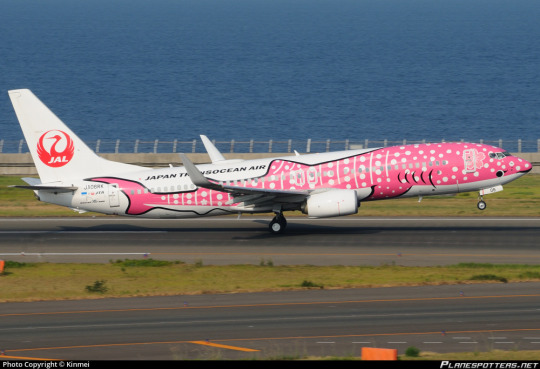
These are just a pair of really pretty and endearing planes, and I could not adore them more. I think I prefer the vivid pink of Sakura Jinbei, but I also do love the classic blue color. And I think the knowledge that these two are a pair improves each of them even more. They're simply lovely.


An A for Jinbei and Sakura Jinbei!
#tarmac fashion week#grade: a#era: 2010s#era: 2020s#region: east asia#region: japan#japan transocean air#japan airlines#aquairium#requests#special liveries
129 notes
·
View notes
Text
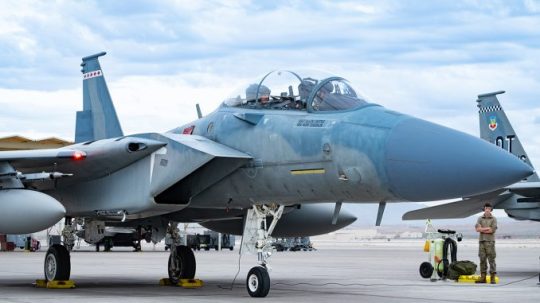
Boeing Is Evaluating The F-15EX As Successor Of The EA-18G Growler
The new “Wild Weasel” variant of the F-15EX would make use of both existing capabilities of the aircraft, as well as new ones integrated from the Growler.
Stefano D'Urso
F-15EX Growler
An F-15EX Eagle II prepares to taxi for a training mission at Nellis Air Force Base, Nevada, Nov. 15, 2023. An upgraded version of the F-15 fourth-generation fighter jet, the F-15EX boasts a new electronic warfare system and an open mission systems architecture with advanced battle management systems. (U.S. Air Force photo by Airman 1st Class Elizabeth Tan)
As the production line of the F/A-18 is about to close, Boeing is studying whether the F-15EX Eagle II can be equipped to become the successor of the EA-18G Growler. The new “Wild Weasel” variant of the F-15EX would make use of both existing capabilities of the aircraft, as well as new ones integrated from the Growler.
“We are evaluating the technical feasibility of combining EA-18G-like capabilities with the F-15EX platform,” said Rob Novotny, Boeing’s executive director for Fighters Business Development. Novotny added that the study is still in the initial stage, but the company is already eyeing opportunities both for NATO members and the Indo-Pacific.
The move is due to the planned stop to the production of the F/A-18E/F Super Hornet in 2027, which in turn means the production of the EA-18G Growler will also end. On the other hand, the production of the Advanced Eagle is expected to continue for many years and leaves the door open to a new specialized variant for Electronic Warfare (EW).
“Modern aerial combat requires command of the electromagnetic spectrum, and this platform would lead the way into the next decade or two,” Novotny said. He also pointed out that the Eagle II offers several design advantages, including the aircraft’s range, speed, computing power and payload capacity.
F-15EX Growler

An F-15EX assigned to the 85th Test and Evaluation Squadron. (U.S. Air Force photo by 2nd Lt. Mary Begy)
One could argue that a low-observable, or stealth, aircraft like the F-35 could be better suited for the job, however Novotny mentioned that stealth shouldn’t be understood strictly in terms of low-observable coatings. In fact, similarly to the Growler, such capabilities could be also replicated by using advanced EW functions.
“Stealth means, to me, I can go to a place where the enemy doesn’t want me to go, and I can operate in their environment, achieve my objective, and not be targeted,” said Novotny.
The F-15EX is already equipped with advanced EW capabilities thanks to the Eagle Passive Active Warning Survivability System (EPAWSS), but it also has the ability to carry the AGM-88 High-Speed Anti-Radiation Missiles (HARMs). In addition to these, Boeing is exploring also the possibility to integrate the AGM-88G Advanced Anti-Radiation Guided Missile-Extended Range (AARGM-ER) and the Next Generation Jammer (NGJ) pods. Still, there’s no naval variant of the Eagle II, therefore, it looks like such a successor of the EA-18G could not operate from the flight deck of an aircraft carrier unlike the Growler.
U.S. Navy EA-18G Growlers assigned to the Electronic Attack Squadron 138 (VAQ-138) fly in formation over the Pacific Ocean, June 24, 2024. The EA-18G’s vast array of sensors and weapons provides the warfighter with a lethal and survivable weapon system to counter current and emerging threats. (U.S. Air Force photo by Senior Airman Tylir Meyer)
The F-15EX and the existing EW capabilities
The new F-15EX, developed from the F-15QA that was the most advanced Eagle variant, comes from a series of needs mainly emerged after the National Defense Strategy directed the U.S. armed services to adapt to the new threats from China and Russia. The aircraft, while extremely similar to the QA variant, features some US-only capabilities like the new AN/ALQ-250 Eagle Passive Active Warning Survivability System (EPAWSS) electronic warfare and electronic surveillance system and Open Mission Systems (OMS) architecture.
The F-15EX’s systems are powered by the Advanced Display Core Processor II, reportedly the fastest mission computer ever installed on a fighter jet, and the Operational Flight Program Suite 9.1X, a customized variant of the Suite 9 used on the F-15C and F-15E, designed to ensure full interoperability of the new aircraft with the “legacy Eagles”.
The F-15EX is equipped with the AN/APG-82(V)1 Active Electronically Scanned Array (AESA) radar, developed from the APG-63(V)3 AESA radar of the F-15C and the APG-79 AESA radar of the F/A-18E/F. This radar allows the Eagle II to simultaneously detect, identify and track multiple air and surface targets at longer ranges compared to mechanical radars, facilitating persistent target observation and information sharing for a better decision-making process.
EPAWSS, an US-only system that will be retrofitted also to the F-15E, provides full-spectrum EW capabilities, including radar warning, geolocation, situational awareness, and self-protection to the F-15. Because of this, the system enables freedom of maneuver and deeper penetration into battlespaces protected by modern integrated air defense systems.
F-15EX Growler
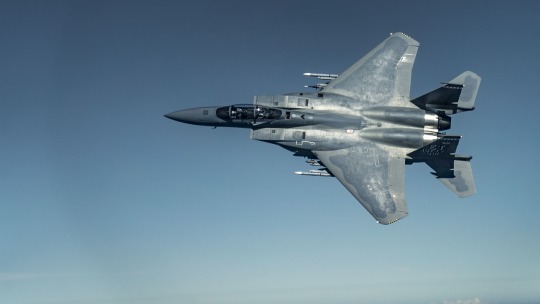
U.S. Air Force Lt. Col. Richard Turner, 40th Flight Test Squadron commander flies 40 FLTS Senior Enlisted Leader, MSgt Tristan McIntire during a test sortie in the F-15EX Eagle II over the Gulf of Mexico on Jun. 14, 2022. Assigned to the 96th Test Wing at Eglin Air Force Base, Fla., the F-15EX Eagle II is the Air Force’s newest 4th generation fighter being tested at the 40 FLTS. (U.S. Air Force photo by Tech. Sgt. John McRell)
EPAWSS is fully integrated with radar warning, geo-location and increased chaff and flare capability to detect and defeat surface and airborne threats in signal-dense and highly contested environments. The system is currently not integrated with the AN/AAR-57A(V) Common Missile Warning System (CMWS) designed to detect infrared threats, even if the F-15EX features the same mounting points used for these sensors on the F-15QA and F-15SA.
Chaff and flares capacity has been increased by 50%, with four more dispensers added in the EPAWSS fairings behind the tail fins (two for each fairing), for a total of 12 dispenser housing 360 cartridges. This improvement is important as in modern scenarios chaff and flares are often released preemptively to counter MANPADS (Man Portable Air Defense System), meaning that now the Eagle will have more countermeasures available for a better protection.
EPAWSS also integrates cognitive electronic warfare to better discriminate the signals received by the system. This capability was demonstrated during the Northern Edge 2023 large force exercise test event, which tested EPAWSS’ ability to rapidly respond to previously unencountered electromagnetic threats. The tests challenged the system’s ability to process in-mission sensor data, create exquisite techniques, and optimize waveforms in real time.
As for the kinetic capabilities, the F-15EX can carry the AGM-88 HARM on outboard wing stations 1 and 9. This capability is reportedly a product of the fly-by-wire upgrade funded by the Royal Saudi Air Force during the development of the F-15SA.

An F-15EX Eagle II from the 85th Test and Evaluation Squadron, 53rd Wing, takes flight out of Eglin Air Force Base, Florida, April 11, 2024, with U.S. Air Force Chief Master Sgt. David Wolfe, command chief of Air Combat Command, and Maj. Scott Addy, 85th Test and Evaluation Squadron, F-15 division chief. The F-15EX is the first Air Force aircraft to be tested and fielded from beginning to end, through combined developmental and operational tests. (U.S. Air Force photo by Capt. Lindsey Brewer)
The EA-18G and the capabilities it could pass to the F-15EX
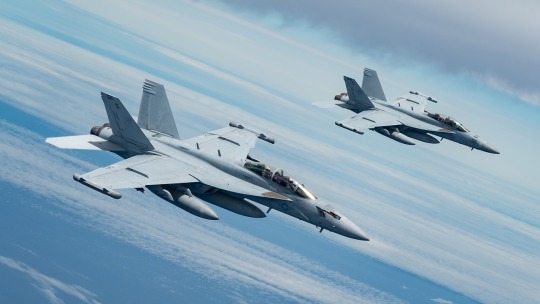
Based off of the F/A-18F, the Growler is a highly specialized Electronic Attack variant of the Super Hornet. The most noticeable difference with the baseline SH is the presence of the wingtip pods housing the ALQ-218 signals receiver suite, which helps to detect and geolocate emitters and signals.
The AN/ALQ-218 is a high performance RWR/ESM/ELINT system that allows the aircraft collect data about sources of radio frequency (RF) emissions: with this sensor, the EA-18G can “sniff” hostile radio signals to update the EOB (Electronic Order of Battle) of the combat theater where the aircraft is employed.
The EA-18G is equipped with an airborne electronic attack (AEA) avionics suite that has evolved from the EA-6B’s Improved Capability III (ICAP III) AEA system. In the future, with the Block II Growler upgrade and the NGJ (Next Generation Jamming) pods, the Growlers will also have Cyber Attack capabilities that will allow the EA-18Gs to “hack” or inject malware into enemy network.
The NGJ program aims to give the EA-18G fleet advanced airborne electronic attack capabilities through three frequency-focused increments – high-band, mid-band and low-band: in other words, the Growlers will replace the TJS pods operating in the 509 MHz to 18 GHz waveband, using three different pods, designated NGJ-LB (also known as Block/Increment 2), NGJ-MB (Capability Block/Increment 1), and NGJ-HB (Block/Increment 3) and directed specifically against the low- (100 MHz to 2 GHz waveband), mid- (2 GHz to 6 GHz), and high-band (6 GHz to 18 GHz) sections of the overall threat spectrum.
NGJ-MB is a high-capacity and power airborne electronic attack weapon system designed for the EA-18G electronic attack aircraft that was designed to carry out the usual job of denying, degrading and disrupting threat radars and communication devices, from an extended range and with enhanced ability than the previous AN/ALQ-99 tactical jamming pods, developed for the EA-6B Prowler.
The NGJ-MB, also known as the AN/ALQ-249(V)1 pod, uses directional emitters and AESA (active electronically scanned array) technology and an all-digital back end. It also has digital and software-based tech embedded in the design, which increases the ability to jam and allows for rapid beam steering and advanced jammer modulation.
While the NGJ-MB pod will “cover the majority of critical threats”, NGJ-LB will be extremely important to provide cover to stealth aircraft, threatened by the emerging counter-stealth Low Band radars, engaging enemy threats from increased stand-off distances and employing increased capacity (number of jamming assignments).
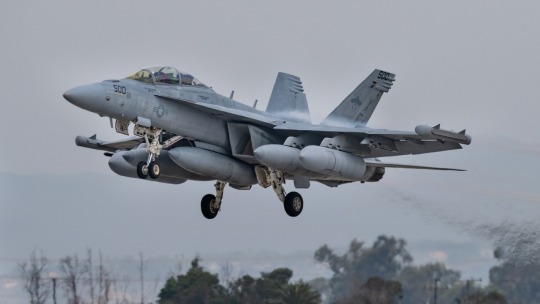
Loaded with external fuel tanks [and NGJ pods, ndr], an EA-18G Growler attached to the U.S. Navy’s Air Test and Evaluation Squadron Nine (VX-9) — the Vampires — goes airborne at Naval Base Ventura County Point Mugu in Southern California on Aug. 10, 2023, on its way to the adjacent Point Mugu Sea Range for a training exercise. The Growler is a two-seat variant of the carrier-based F/A-18 Super Hornet that is designed for electronic warfare. (U.S. Navy photo by Eric Parsons/Released)
NGJ-MB will replace one of high-band ALQ-99 pods that Growlers carry under each wing, while the NGJ-LB will replace the low-band pod that the aircraft carry on the centerline store position under the fuselage (the third one, a high-band pod, being developed as part of the so-called Increment III, will be carried on the left wing).
The Growler is also capable of carrying the HARM (High speed Anti-Radiation Missile) and AARGM (Advanced Anti-Radiation Guided Missile); these weapons are designed to seek out threat weapons systems and emitters, guiding on their energy, and destroy them. However, the EA-18G is expected to integrate also the new AARGM-ER.
The AARGM-ER is the evolution of the latest variant of the AGM-88 HARM (High-Speed Anti-Radiation Missile), the AGM-88E AARGM, a medium-range air-to-ground missile employed for Suppression and/or Destruction of Enemy Air Defenses (SEAD/DEAD). The AGM-88E is the result of a cooperative program with the Italian Air Force started in 2005 and developed as an upgrade and compliment to the AGM-88B/C. The AARGM program designed and produced a new Guidance Section and modified the existing Control Section, which are coupled with the legacy HARM Rocket Motor and Warhead Section, wings and fins.
The new Guidance Section features a passive anti-radiation homing receiver, satellite and inertial navigation system and a millimeter wave radar for terminal guidance, with the added ability to send images of the target via a satellite link before impact. The purpose of these new Guidance Section is to improve the effectiveness of the legacy HARM, especially against enemy radar and communications sites that would shut down to confuse incoming anti-radiation missiles (counter-shutdown capability) or pop-up threats.
As stated by the U.S. Navy, AARGM baseline capabilities include an expanded target set, counter-shutdown capability, advanced signals processing for improved detection and locating, geographic specificity providing aircrew the opportunity to define missile-impact zones and impact-avoidance zones, and a weapon impact-assessment broadcast capability providing for battle damage assessment cueing.
The AARGM-ER builds up on these capabilities to obtain an even more advanced weapon that is being integrated on the F/A-18E/F Super Hornet and EA-18G Growler and it is compatible for a future integration on all the variants of the F-35 Lightning II. The AARGM-ER combines the Guidance Section and Control Section of the AGM-88E with a new, larger rocket motor and a new warhead. The control surfaces have been redesigned too, obtaining aerodynamic strakes along the sides for increased lift and low-drag tail surfaces. The missile will reportedly have roughly double the range and speed of the AGM-88E.
About Stefano D'Urso
Stefano D'Urso is a freelance journalist and contributor to TheAviationist based in Lecce, Italy. A graduate in Industral Engineering he's also studying to achieve a Master Degree in Aerospace Engineering. Electronic Warfare, Loitering Munitions and OSINT techniques applied to the world of military operations and current conflicts are among his areas of expertise.
@TheAviationist.com
16 notes
·
View notes
Text
When two American astronauts blasted off on a test mission to the International Space Station on 5 June, they were expecting to be back home in a matter of days.
But things didn't quite go to plan.
In fact, Barry “Butch” Wilmore and Sunita Williams are still there, floating high above the Earth nearly two months later.
The pair - who are stuck indefinitely - now face the sudden prospect of missing the summer entirely and even spending Christmas and New Year in space.
Mr Wilmore, 61, and Ms Williams, 58, flew a Boeing Starliner spacecraft to the station. It was the first flight of its kind with people on board and was a test designed to see how the new spacecraft performs before it is used more regularly.
Problems, however, emerged as it made its approach. These included leaks in its propulsion system and some of its thrusters shutting down.
So while they made it to the space station safely, they will need an alternative mode of transport to get home if the Starliner is not deemed safe to return to Earth.
At a news briefing on Wednesday, Nasa officials said no firm decisions had been made when it comes to next steps.
"Our prime option is to return Butch and Suni on Starliner," Steve Stich, manager of Nasa's Commercial Crew Program, said. "However, we have done the requisite planning to make sure we have other options open.”
One potential option being considered, they said, is to attach the two astronauts to a mission that is scheduled to launch in September, and return them to earth with that mission in February 2025.
That flight to the space station will be made by a SpaceX Crew Dragon craft. The initial plan was for four crew members to be aboard, but two of the seats could be left empty if needed.
That plan would mean the astronauts would spend more than eight months – rather than eight days – aboard the International Space Station (ISS).
If the Crew Dragon is used, the Starliner craft would be returned to Earth without any crew, under computer control.
Nasa officials said it could take a week or more for a final decision to be made.
What a year in Space does to the body
Starliner: The US Space industry's next big thing?
Ken Bowersox, Nasa's director of space operations, told reporters the chances of an uncrewed return of the Starliner “have increased a little bit based on where things have gone over the last week or two.”
"That's why we're looking more closely at that option to make sure that we can handle it," he said.
Using a SpaceX craft to return the astronauts would be a blow to Boeing, which has for years tried to compete with the company and its more experienced Crew Dragon.
Earlier this week, Nasa used a SpaceX rocket to deliver more food and supplies to the ISS, including extra clothes for the two astronauts.
Last month, in a short press briefing, the pair said they were "absolutely confident” in the return trip and Starliner was “truly impressive.”
This is the third stint aboard the ISS for Ms Williams, a retired Navy helicopter pilot, while Mr Wilmore is a former fighter jet pilot who has been to space twice before.
“We've been thoroughly busy up here, integrated right into the crew,” Ms Williams told reporters during a recent briefing call.
“It feels like coming back home. It feels good to float around. It feels good to be in space and work up here with the International Space Station team," she said. "So yeah, it’s great to be up here.”
Boeing was hoping that the maiden Starliner mission would pave the way for regular use of its capsule for missions back and forth to the station. The Space X Crew Dragon has been approved for Nasa missions since 2020.
Although the astronauts will spend much more time in space than they initially planned, others have spent much longer periods above the Earth's surface. Russian Valeri Polyakov spent 437 days in space in aboard the Mir space station in the mid-1990s.
Last year, Frank Rubio returned from the ISS after 371 days, the longest time an American has spent in space.
And Russia's Oleg Kononenko, also currently aboard the ISS, is the first person to have spent more than 1,000 days in space during the course of their career.
In their briefings and interviews, the two Americans have been upbeat about their situation. "I’m not complaining that we’re here for a couple extra weeks," Ms Williams said last month.
As things stand, the pair may be there for many more weeks to come.
8 notes
·
View notes
Note
weird situation happened to me and can't find any relevant info about it. I saw an unmarked, white, short-body 737 flying pretty low, maybe at only a thousand or fifteen hundred feet, heading west, then make two 90° right turns and head back east. When I got home I checked flightradar24's archives for the last hour or so but it never showed up. Thoughts?
Hmm, I'm not sure exactly. Maybe some kind of military training exercise in a C-40 or P-8? It could also be a Boeing Business Jet, and if there was an airport nearby it could have been doing a visual or a circling approach, but if not I have no idea why it would be flying and maneuvering so low.
15 notes
·
View notes
Photo









Boeing 737-700
Courtesy: Global Jet
#art#design#interiors#boeing business jet#Business jet#boeing#boeing 737-700#globajjet#private jet#jetset#Jetsetter#aircraft#airplane#flying palace#flyingprivate#flyingpalace#billionairelife#travels#billionaire
50 notes
·
View notes
Text
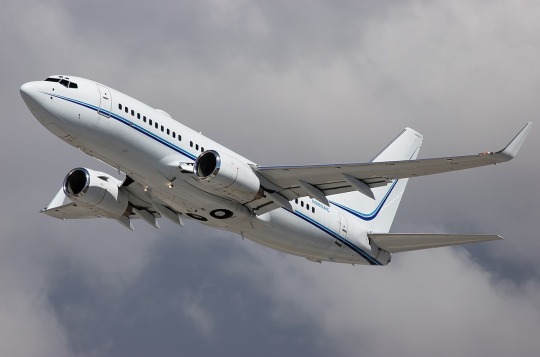
Boeing 737-7AV (BBJ) climbing out of LAX
#Boeing#Boeing Business Jet#BBJ#737#luxury jet#private jet#business jet#charter aircraft#airplane#plane#flying
23 notes
·
View notes
Text
THE SPIRIT OF EA NASIR LIVES!
11 notes
·
View notes
Photo

Qu'est-ce que ça vous fait, quand vous tirez? Ah! Vous voyez bien que ça vous intéresse! Je vais vous le dire. Ça fait boum dans les oreilles.
- Alain Delon, Les Clan des Siciliens (1969)
Les Clan des Siciliens (1969) boasted three of the leading French male actors of their time in the form of Alain Delon, Jean Gabin, and Lino Venturo.
Jean Gabin is Vittorio Manalese, the head of the Sicilian Manalese clan in Paris, Alain Delon the reckless, amoral French criminal and killer Roger Sartet, who hires Vittorio’s clan to spring him from custody, and Lino Ventura Commissaire Le Goff, the man who first captured Roger, hunts Roger down and bring him to justice. Manalese partners Sartet with a gangster from New York to organise a heist. It doesn’t end well for either Sartet or Manalese with Sartet on dangerous ground having an affair with Manalese’s daughter-in-law and Goff ever closer to capturing them both.
Even in 1968, the film lined up classic detective story ingredients: mobsters, a cop hell-bent on capturing them, a sensational heist and, because there are Sicilians, a revenge of honour. With all these conventions, the film was scorned by the intellectual critics who usually despised this kind of gangster cinema that was also appealed to the taste of the populist masses. After watching it again I think the film critics were being supercilious and snobbish.
The Clan of the Sicilians is immensely enjoyable and beautifully crafted under the precise and spectacular direction as Verneuil. One of the more stunning bravura set pieces was the landing of a Boeing jumbo jet landing on a busy New York motorway. The film is a curious but happy hybrid of a traditional French detective film that also had American sensibilities. Above all it has the gorgeous music of Ennio Morricone as a soundtrack.
#delon#alain delon#quote#french#french cinema#film#movie#the sicilian clan#gangster#le clan des siciliens#art#french culture#vintage#jean gabin#lino venturo
68 notes
·
View notes
Text
Music
When Bob Dylan ‘Flew Too Close to the Sun’ and Came Out a Rock God
NO LIMIT
Bob Dylan’s nostalgia-packed 1974 tour with The Band gets a massive 27-disc box set—and reveals the most impressive reinvention of his career.
Jeff Slate
Updated Sep. 21, 2024 3:51PM EDT Published Sep. 21, 2024 5:00AM EDT

Barry Feinstein
In retrospect, Bob Dylan likened his 1974 reunion tour with The Band to Elvis Presley’s “Fat Elvis” period. It was powerful, sure, but it was nostalgia; creatively unsatisfying. And a cash grab. Ultimately, it showed him the way he didn’t want to go forward, as he recalled in 2004 in Chronicles, Vol.1.
Still, 1974 was a landmark year in rock ’n’ roll, and it was Bob Dylan and the Band who kicked it off in January, playing 40 shows during their six-week trek together—a groundbreaking feat in and of itself—often putting on matinee and evening arena shows to satisfy demand.
If, during his Thin Wild Mercury music period in the mid-1960s, Dylan had given songwriting a new vocabulary, and had created the look and attitude of the modern rock star, in 1974 he updated all of that for a new era, for good measure adding a tour that presaged the bloated, arena-filling tours that would become, and remain, a staple of the music business.
Dylan, who’d released a couple of laid-back country-tinged albums and had performed sparingly since his last tour with The Band in 1966, had signed a new record deal with David Geffen’s Asylum Records—leaving the storied Columbia label—and was about to have his first #1 record, Planet Waves, recorded with The Band. Geffen enlisted the legendary promoter Bill Graham to handle the organization of the entire tour, a highly unusual move at the time, with tickets sold via a mail in lottery. Dylan and The Band even traveled cross-country by private plane, a Boeing 720 passenger jet.
“It was a mythical tour, even at the time,” explains Rolling Stone’s David Browne, the author of the new book Talkin' Greenwich Village: The Heady Rise and Slow Fall of America's Bohemian Music Capital, which chronicles the fabled New York City neighborhood, and is particularly strong in how it deals with Dylan during the mid-’70s. “Dylan hadn’t toured in eight years, and, at least to my knowledge, none of it was filmed,” he adds. “Plus, it was the only tour he did with The Band after the ’60s, and it was a greatest hits tour, where Dylan was reintroducing himself to the world. All of those things together have given it this mystique, I think. When you add all those things up, it does give the tour this added allure.”
Of course, these weren’t the trailblazing, amphetamine-enhanced pied pipers of the 1966 tour, where at just about every stop they’d been booed. While everything that was frenetic and swinging about the ’60s was on full display on The 1966 Live Recordings box set, now, eight years later, the grim hangover that was the 1970s was upon everyone, and Dylan and The Band’s music and collective attitude while on the road early that year reflected all the weirdness, darkness and edginess that entailed.

The 1974 Live Recordings celebrates the 50th anniversary of Bob Dylan’s return to touring that year.
Legacy Recordings
“A lot of the revelations on here are on the first five to 10 discs,” says Ray Padgett, the author of Pledging My Time: Conversations with Bob Dylan Band Members. “Hearing the trajectory of the playing, and hearing Dylan’s vocals go from nuanced to beautiful to almost shouting practically every word, is fun to follow along show by show.”
The Band, of course, were a force in their own right by 1974, having released the era-defining albums Music from Big Pink, The Band and Stage Fright. But perhaps even more importantly, they had backed Dylan on that legendary ’66 tour. So, even if it was Dylan everyone was really coming to see, there was a healthy dose of nostalgia afoot.
“The year 1974 is interesting, because that was the year that was the beginning of pop culture nostalgia,” says Browne. “Because you had not just Dylan and The Band reuniting for a greatest hits tour of songs from the sixties, but you had Crosby, Stills, Nash and Young reuniting for their tour, you had American Graffiti, you had Happy Days starting, Grease was on Broadway, a hit musical. Suddenly, in 1974, the culture, for whatever mysterious reason, was looking back at the mid-to-late-’50s to the early-’60s. In fact, one of the big summer hits that year was a song called “Beach Baby” by The First Class, which was basically a fake Beach Boys song, who, ironically, made their big comeback with the greatest hits double album Endless Summer. That was 1974.”
Perhaps nowhere is that nostalgia more evident than during Dylan’s nightly acoustic sets. Older and certainly more world-weary than the man who had wowed and confounded audiences in the previous decade, Dylan attacks some of his most famous songs with a ferociousness that simply wills you to listen. Suddenly, the songs that had made him the voice of a generation seem recast for the weird and wild 1970s, with a keen sense of the foreboding that seemed to be everywhere.
“You can argue that this period—the Planet Waves album and the '74 tour—is kind of an official entry point into Dylan's second act as an artist,” says Elizabeth Nelson, who wrote the liner notes for The 1974 Live Recordings. “He has become a legend, flown too close to the sun, retreated into domesticity, and now is officially reentering the great public arena, a wizened gladiator. The whole period is one wherein he essentially signs the blood pact of being a public person forever.”
The recordings themselves are a mixture of crystal-clear mixes from multi-track tapes, to the occasional muddy and hissy board mix. But that’s no doubt the price you pay for such completeness. Besides, the highlights are plentiful: the opening night in Chicago, the Jan. 7 show at Philly’s Spectrum, the Jan. 27 matinee in Houston, and the final night in Los Angeles.
“What struck me, beyond the normal stuff you would expect to hear on a long tour—the players tightening up as the shows unfold, and then exhaling a bit—was how much they seemed to start out the tour on almost a war footing with the audience,” adds Nelson. “Robbie Robertson talks in the documentary Once Were Brothers about how strange and traumatizing being booed off stage practically every night in 1966 was, and you can tell that there was still some real scar tissue there. When they come out the first night and start with ‘Hero Blues,’ the deepest of deep cuts, it’s almost like they’re testing the audience to see how deep their loyalties run. As the tour progresses, and they evolve a more fan friendly set, you can almost sense the growing realization and relief that they are being well received.”
“It’s a strange thing, and you don’t sense that the question of that trust between performer and audience is ever fully resolved,” she continues. “Even at its most crowd pleasing, the shows run on a razor’s edge of intensity.”
Jeff Slate
3 notes
·
View notes
Text
Boeing's plagued Starliner spacecraft will officially return without any astronauts on board, following what has proven to be a disastrous first crewed test flight.
Before the mission even launched, engineers noticed several gas leaks affecting the capsule's propulsion system. The situation spiraled once the spacecraft made it to the space station — and over the weekend, NASA revealed that it had weighed the risks and decided Starliner was simply too dangerous for its two stranded astronauts Sunita Williams and Butch Wilmore to use.
Worst of all, the affected thrusters are attached to Starliner's service module, which is designed to separate from the crew module during re-entry and burn up in the Earth's atmosphere.
That could make it far more difficult for Boeing to figure out what went wrong, as that won't leave any hardware behind for engineers to inspect. As Ars Technica reports, that could massively hamper Boeing's investigation into what went wrong.
It's an anticlimactic end to what is proving to be a major setback for Boeing, a company already under heavy scrutiny for its troubled commercial jet business.
3 notes
·
View notes
Text

Canada selects Boeing's P-8A Poseidon as its new multi-mission aircraft
The partnership with Canadian industry will provide long-term economic prosperity to Canada 🇨🇦
Fernando Valduga By Fernando Valduga 11/30/2023 - 18:52 in Military
With the P-8, Canada guarantees the interchangeability of allies NORAD and FIVE EYES.
The government of Canada signed a letter of offer and acceptance of foreign military sales for up to 16 Boeing P-8A Poseidon aircraft, as part of the Canadian Multimission Aircraft Project (CMMA).
Canada joins eight defense partners, including all allies of FIVE EYES, the intelligence alliance that also includes the United States, the United Kingdom, Australia and New Zealand, and becomes the fifth NATO nation to have selected the P-8 as its multi-mission aircraft. The first delivery is scheduled for 2026.

“The P-8 will strengthen Canada's defense capability and readiness, and we look forward to delivering that capability to the Royal Canadian Air Force,” said Heidi Grant, president of Business Development at Boeing Defense, Space & Security. “Together with our Canadian partners, we will deliver a strong package of industrial and technological benefits that will ensure continued prosperity for Canada's aerospace and defense industry.”
The P-8 is the only proven in-service and production solution that meets all CMMA requirements, including range, speed, strength and payload capacity. This decision will benefit hundreds of Canadian companies and bring decades of prosperity to Canada through the support of the platform provided by our Canadian industrial partners.
The acquisition of P-8 will generate benefits of almost 3,000 jobs and $358 million annually in economic output for Canada, according to a 2023 independent study by Ottawa-based Doyletech Corporation.
“This is a very important day for the Royal Canadian Air Force and Boeing,” said Charles 'Duff Sullivan, managing director of Boeing Canada. "The P-8 offers unparalleled capabilities and is the most affordable solution for acquisition and life cycle maintenance costs. There is no doubt that the P-8 will protect Canada's oceans and borders for future generations."

The partnership with Canadian industry will provide long-term economic prosperity to Canada.
The Poseidon Team is the cornerstone of Boeing's Canadian P-8 industrial partnership, composed of CAE, GE Aviation Canada, IMP Aerospace & Defense, KF Aerospace, Honeywell Aerospace Canada, Raytheon Canada and StandardAero. The team is based on the 81 existing Canadian suppliers for the P-8 platform and more than 550 Boeing suppliers in all provinces, contributing to the company's annual economic benefit of approximately CAD$ 4 billion for Canada, supporting more than 14,000 Canadian jobs.
With more than 160 aircraft delivered or in service and 560,000 collective flight hours, the P-8 has proven capabilities for anti-submarine warfare, anti-surface warfare, intelligence, surveillance, reconnaissance and humanitarian assistance/disaster relief response.
Tags: Military AviationBoeingP-8A PoseidonRCAF - Royal Canadian Air Force/Canada Air Force
Sharing
tweet
Fernando Valduga
Fernando Valduga
Aviation photographer and pilot since 1992, has participated in several events and air operations, such as Cruzex, AirVenture, Dayton Airshow and FIDAE. He has work published in specialized aviation magazines in Brazil and abroad. Uses Canon equipment during his photographic work in the world of aviation.
Related news
BRAZILIAN AIR FORCE
UFSM receives A-1 jet donated by FAB
30/11/2023 - 18:01
One of the first of the 32 F-16s for Romania being delivered by the Norwegian Minister of Defense on November 28. (Photo: Norwegian Armed Forces)
MILITARY
Romania receives first F-16s that were from the Norwegian Air Force
11/30/2023 - 5:00 PM
HELICOPTERS
Norway says goodbye to its last Westland Sea King helicopter
11/30/2023 - 4:00 PM
MILITARY
HENSOLDT supports BAE Systems in the development of the Striker II fighter pilot helmet
11/30/2023 - 2:00 PM
MILITARY
First Belgian F-35A Lightning II starts painting process
11/30/2023 - 1:00 PM
AIR CARGO
Atlas Air places new order for Boeing 777F freighters
11/30/2023 - 10:30
19 notes
·
View notes